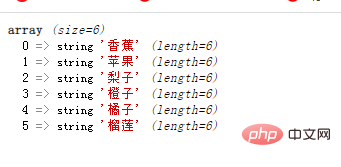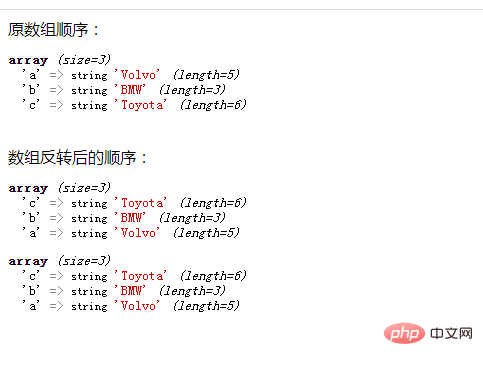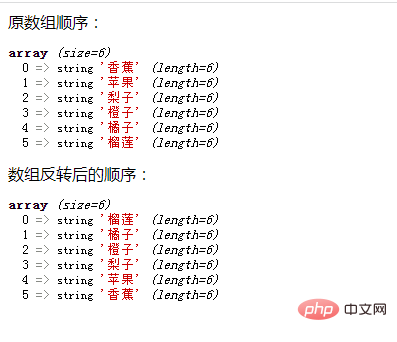Home >Backend Development >PHP Problem >What function does php use to reverse arrays?
What function does php use to reverse arrays?
- 青灯夜游Original
- 2022-09-16 19:38:452391browse
In PHP, you can use the array_reverse() function to reverse the array. The array_reverse() function will reverse the order of the elements in the array, create a new array and return it. The syntax is "array_reverse(array,preserve)"; the parameter preserve can be omitted and is used to specify whether to retain the key names of the original array (only for numbers) Key name, non-numeric keys are not affected).

The operating environment of this tutorial: windows7 system, PHP version 8.1, DELL G3 computer
In PHP, you can use array_reverse () function to implement array reversal.
array_reverse() function returns an array in the reverse order of elements; it reverses the order of elements in the original array, creates a new array, and returns it.
Grammar format:
array_reverse(array,preserve)
| Parameters | Description |
|---|---|
| array | Required. Specifies an array. |
| preserve | Optional. Specifies whether to retain the original array key names. If set to TRUE, numeric keys will be preserved. Non-numeric keys are not affected by this setting and will always be retained. Possible values:
|
<?php
header("Content-type:text/html;charset=utf-8");
$array= array("香蕉","苹果","梨子","橙子","橘子","榴莲");
var_dump(array_reverse($array));
var_dump(array_reverse($array,true));
?>Original array:


- The preserve parameter can be omitted , used to specify whether to retain the key names of the original array (only for numeric key names, non-numeric keys are not affected).
<?php
header('content-type:text/html;charset=utf-8');
$arr =array("a"=>"Volvo","b"=>"BMW","c"=>"Toyota");
echo "原数组顺序:";
var_dump($arr);
echo "<br>数组反转后的顺序:";
var_dump(array_reverse($arr));
var_dump(array_reverse($arr,true));
?>

Extended knowledge: Use the for loop statement to reverse the index array
<?php
header('content-type:text/html;charset=utf-8');
$array= array("香蕉","苹果","梨子","橙子","橘子","榴莲");
echo "原数组顺序:";
var_dump($array);
for ($i=count($array)-1; $i>=0 ; $i--) {
$res[]=$array[$i];
}
echo "数组反转后的顺序:";
var_dump($res);
?>

PHP Video Tutorial"
The above is the detailed content of What function does php use to reverse arrays?. For more information, please follow other related articles on the PHP Chinese website!

